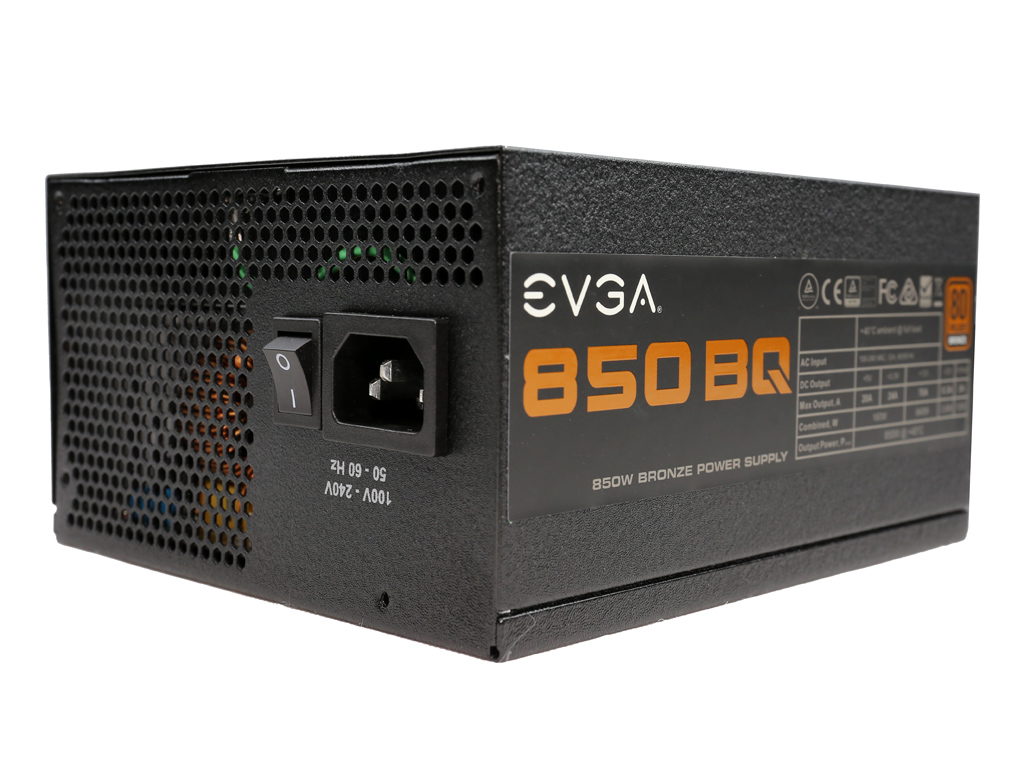EVGA BQ Series 850W PSU Review
One of EVGA's most affordable power supply families, the BQ, includes five unique models. The higher-capacity ones are made by HEC and the rest come from Andyson. Today we're testing the flagship 850 BQ.
Why you can trust Tom's Hardware
Pros, Cons, And Final Verdict
We can't say the 850 BQ managed to impress us. Although it registers a fairly high performance per dollar score thanks to its affordable price, the unit's absolute performance isn't up to the levels we want to see. Load regulation is very loose, ripple suppression on the minor rails is mediocre, and the 3.3V rail's transient response is weak. To make matters worse, the efficiency levels are quite low, the inrush current under both voltage inputs (115V and 230V) is high, and the cooling fan is loud, even though it uses a reliable bearing. In order to keep the Teapo SC capacitors on the secondary side cool (along with the SBRs responsible for rectifying the +12V rail), HEC went with an aggressive fan profile that sets the minimum rotational speed at 1120 RPM! So, if you hate noisy PSUs, stay away from this one.
On the bright side, the 850 BQ offers a decent hold-up time and its power-good signal is accurate. The +12V rail's response to transient loads is pretty good for this price category, and you get a respectable number of connectors, allowing you to configure a potent system without any problems.
For $85, you get a 850W semi-modular power supply with lots of connectivity and a five-year warranty, so we probably shouldn't be super picky. But for a few dollars more you can find some nice Gold-rated PSUs capable of much higher efficiency. Besides cutting your electricity bill, they'll also run more quietly since their fans don't have to cope with as much waste heat.
Let's face it, 80 PLUS Bronze PSUs are living their last days. It's actually pretty hard to find new (and worthwhile) offerings in this category; Gold-class PSUs are more affordable than they used to be, after all. If the price difference was $20 or more, it'd probably be worth considering the best Bronze-rated models. But EVGA's 80 PLUS Gold 850 GQ sells for around $100. That's close to a $10 gap. So, we think the higher-efficiency PSU is a better buy.
The list of upgrades to the 850 BQ should include higher-quality caps on the secondary side, better ripple suppression on the minor rails, tighter load regulation, and a more conservative fan profile. However, with the help of our IR camera, we noticed that the +12V regulation SBRs can get quite hot in a matter of seconds, even under moderate loads (and the PSU operating in passive mode). This means extra work for the fan. Since HEC wanted to be on the safe side rather than dealing with warranty returns, it armed this unit with a reliable fan that'll spin quickly for most of its lifetime. No doubt, the company went with a TNB fan over a plain sleeve bearing one to make its five-year guarantee viable.
MORE: Best Power Supplies
MORE: Power Supplies 101
Get Tom's Hardware's best news and in-depth reviews, straight to your inbox.
MORE: How We Test Power Supplies
MORE: Picking The Right Power Supply: What You Should Know
MORE: Computer History: From The Antikythera Mechanism To The Modern Era
MORE: All Power Supply Content
Follow us on Facebook, Google+, RSS, Twitter and YouTube.
Current page: Pros, Cons, And Final Verdict
Prev Page Performance, Performance Per Dollar, Noise, And Efficiency Ratings
Aris Mpitziopoulos is a contributing editor at Tom's Hardware, covering PSUs.
-
Metteec Also, for $20 more, you can pick up an equivalent gold rated PSU or maybe even a platinum one on sale and after rebates. It is the halcyon days for competition in quality PSUs.Reply -
_TheD0ct0r_ Reply19020704 said:Thanks for the review. Looks like I will be avoiding this one.
Why is that?
-
Metteec @_THEDICTOR_, for $85, there are so many other better options. EVGA could have been more competitive model if they made quieter version. Instead, you get a PSU with fixed cables, low efficiency, high power variances, and noise like a mini-vacuum. While the higher quality capacitors and warranty are nice, the lack of utility does not make this a good value. 3-years ago, this would have been a great PSU, but times have changed. It is a great day to buy a PSU, just not this one.Reply -
MasterMace appears to be another terrible unit. I'll have to read back and see if it's an Andyson or a HECReply -
Nuckles_56 I would have thought that EVGA could have pushed HEC a bit harder and got a much better unit out of them than thisReply -
lunyone I would personally like to see more 450-550w PSU reviews, not the cherry picked and delivered 750w+ ones that seem to make the rounds. It is just that most people are only going to need 450-550w PSU's for their 1 dGPU based systems.Reply -
Aris_Mp This is not a cherry-picked sample. It comes directly from a store shelf and not from EVGA.Reply
As for more 450-550W PSU reviews, I am currently working on a 500W unit (which however isn't affordable).
